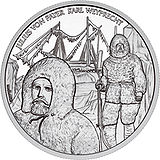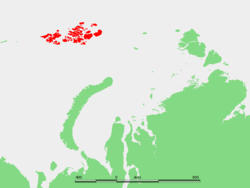
Austro-Hungarian North Pole Expedition
Encyclopedia



Julius von Payer
Julius Johannes Ludovicus Ritter von Payer was an Austro-Hungarian arctic explorer and an Arctic landscape artist....
, one of the leaders, the journey was to find the north-eastern passage
Northern Sea Route
The Northern Sea Route is a shipping lane officially defined by Russian legislation from the Atlantic Ocean to the Pacific Ocean specifically running along the Russian Arctic coast from Murmansk on the Barents Sea, along Siberia, to the Bering Strait and Far East. The entire route lies in Arctic...
. It actually explored the area northwest of Novaya Zemlya
Novaya Zemlya
Novaya Zemlya , also known in Dutch as Nova Zembla and in Norwegian as , is an archipelago in the Arctic Ocean in the north of Russia and the extreme northeast of Europe, the easternmost point of Europe lying at Cape Flissingsky on the northern island...
. According to the other leader, Karl Weyprecht
Karl Weyprecht
Karl Weyprecht, also spelt Carl Weyprecht, was an Austro-Hungarian explorer. He was an officer in the Austro-Hungarian Navy. He is most famous as an Arctic explorer, and an advocate of international cooperation for scientific polar exploration...
, the north pole
North Pole
The North Pole, also known as the Geographic North Pole or Terrestrial North Pole, is, subject to the caveats explained below, defined as the point in the northern hemisphere where the Earth's axis of rotation meets its surface...
was a secondary target. The financing was an estimated total costs 175,000 florins from Austro-Hungarian nobles. The two main financial contributors were Count Johann Nepomuk Wilczek
Count Johann Nepomuk Wilczek
Count Johann Nepomuk Wilczek was an Austro-Hungarian sponsor of Polar expeditions and artists....
(1837–1922) and Hungarian Count Ödön Zichy
Zichy
Zichy , the name of a noble Magyar family, conspicuous in Hungarian history from the latter part of the 13th century onwards.-Brief history of the Zichy:...
(1811–1894)
The main ship was the Tegetthoff, named for the Austrian Admiral
Admiral
Admiral is the rank, or part of the name of the ranks, of the highest naval officers. It is usually considered a full admiral and above vice admiral and below admiral of the fleet . It is usually abbreviated to "Adm" or "ADM"...
Wilhelm von Tegetthoff
Wilhelm von Tegetthoff
Wilhelm von Tegetthoff was an Austrian admiral. Considered one of the prominent naval commanders of the 19th century, Tegetthoff was known for his innovative tactics as well as his inspirational leadership....
, under whom Weyprecht served. The ship was built by Teklenborg & Beurmann in Bremerhaven
Bremerhaven
Bremerhaven is a city at the seaport of the free city-state of Bremen, a state of the Federal Republic of Germany. It forms an enclave in the state of Lower Saxony and is located at the mouth of the River Weser on its eastern bank, opposite the town of Nordenham...
. It was a three-masted schooner
Schooner
A schooner is a type of sailing vessel characterized by the use of fore-and-aft sails on two or more masts with the forward mast being no taller than the rear masts....
of 220 tons, 38.34 m long, with a 100 hp (75 kW) steam engine. The crew came from all over Austria-Hungary, especially from Istria
Istria
Istria , formerly Histria , is the largest peninsula in the Adriatic Sea. The peninsula is located at the head of the Adriatic between the Gulf of Trieste and the Bay of Kvarner...
and Dalmatia
Dalmatia
Dalmatia is a historical region on the eastern coast of the Adriatic Sea. It stretches from the island of Rab in the northwest to the Bay of Kotor in the southeast. The hinterland, the Dalmatian Zagora, ranges from fifty kilometers in width in the north to just a few kilometers in the south....
.
Journey
The Tegetthoff with her crew of 24 left TromsøTromsø
Tromsø is a city and municipality in Troms county, Norway. The administrative centre of the municipality is the city of Tromsø.Tromsø city is the ninth largest urban area in Norway by population, and the seventh largest city in Norway by population...
in July 1872. At the end of August she got locked in pack-ice north of Novaya Zemlya
Novaya Zemlya
Novaya Zemlya , also known in Dutch as Nova Zembla and in Norwegian as , is an archipelago in the Arctic Ocean in the north of Russia and the extreme northeast of Europe, the easternmost point of Europe lying at Cape Flissingsky on the northern island...
and drifted to hitherto unknown polar regions. It was on this drift when the explorers discovered an archipelago which they named Franz-Josef Land after Austro-Hungarian
Austria-Hungary
Austria-Hungary , more formally known as the Kingdoms and Lands Represented in the Imperial Council and the Lands of the Holy Hungarian Crown of Saint Stephen, was a constitutional monarchic union between the crowns of the Austrian Empire and the Kingdom of Hungary in...
Emperor
Emperor
An emperor is a monarch, usually the sovereign ruler of an empire or another type of imperial realm. Empress, the female equivalent, may indicate an emperor's wife or a woman who rules in her own right...
Franz Joseph I
Franz Joseph I of Austria
Franz Joseph I or Francis Joseph I was Emperor of Austria, King of Bohemia, King of Croatia, Apostolic King of Hungary, King of Galicia and Lodomeria and Grand Duke of Cracow from 1848 until his death in 1916.In the December of 1848, Emperor Ferdinand I of Austria abdicated the throne as part of...
.
In May 1874 boat captain Weyprecht decided to abandon the ice-locked ship and try to return by sledges and boats. On 14 August 1874 the expedition reached the open sea and on 3 September finally set foot on Russia
Russia
Russia or , officially known as both Russia and the Russian Federation , is a country in northern Eurasia. It is a federal semi-presidential republic, comprising 83 federal subjects...
n mainland.
The expedition returned to Austria by train from Bremen. Underway, they were invited to dinner parties hosted by different German geographical societies. They entered Vienna in triumph, welcomed, acooreding to contemporary newspaper reports, by hundred thousands of people.
Significance
The expedition's discoveries and experiences made a significant contribution to polar science, especially the discovery of the Northeast passage by Adolf Erik NordenskiöldAdolf Erik Nordenskiöld
Freiherr Nils Adolf Erik Nordenskiöld , also known as A. E. Nordenskioeld was a Finnish baron, geologist, mineralogist and arctic explorer of Finnish-Swedish origin. He was a member of the prominent Finland-Swedish Nordenskiöld family of scientists...
. They also gave an impetus to International Polar Years, meaning a shift from sports-like races of single expeditions to worldwide scientific cooperation in exploring the polar regions.
The expedition yielded various results in the fields of meteorology
Meteorology
Meteorology is the interdisciplinary scientific study of the atmosphere. Studies in the field stretch back millennia, though significant progress in meteorology did not occur until the 18th century. The 19th century saw breakthroughs occur after observing networks developed across several countries...
, astronomy
Astronomy
Astronomy is a natural science that deals with the study of celestial objects and phenomena that originate outside the atmosphere of Earth...
, geodesy
Geodesy
Geodesy , also named geodetics, a branch of earth sciences, is the scientific discipline that deals with the measurement and representation of the Earth, including its gravitational field, in a three-dimensional time-varying space. Geodesists also study geodynamical phenomena such as crustal...
, magnetism
Magnetism
Magnetism is a property of materials that respond at an atomic or subatomic level to an applied magnetic field. Ferromagnetism is the strongest and most familiar type of magnetism. It is responsible for the behavior of permanent magnets, which produce their own persistent magnetic fields, as well...
, zoology
Zoology
Zoology |zoölogy]]), is the branch of biology that relates to the animal kingdom, including the structure, embryology, evolution, classification, habits, and distribution of all animals, both living and extinct...
, and sightings of aurora borealis. They were published by the Academy of Sciences
Academy of Sciences
An Academy of Sciences is a national academy or another learned society dedicated to sciences.In non-English speaking countries, the range of academic fields of the members of a national Academy of Science often includes fields which would not normally be classed as "science" in English...
in 1878. Besides, there are a book (The Austro-Hungarian North Pole Expedition 1872-74) and paintings by Payer - probably the only paintings of a polar expedition created by the explorer himself.
The expedition was selected as main motif for the Austrian Admiral Tegetthoff Ship and The Polar Expedition commemorative coin minted on June 8, 2005. The reverse side of the coin shows two explorers in Arctic gear with the frozen ship behind them.

